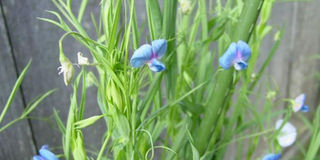Lessons to learn from breeding grass pea as a food security crop

What you need to know:
Apart from the toxicity of the crop coupled with health challenges, the scientists say it is very rich in protein and those who have been consuming it can make flour out of it and others simply cook the seeds as they are.
It is a good idea for farmers and agricultural scientists in Uganda to learn lessons from countries that have been breeding Lathyrus Sativus, commonly known as grass pea, a particularly important crop in areas that are prone to drought and famine.
Belonging to the leguminous crop family, it is thought to be an insurance crop as it produces reliable yields.
While in Uganda, agricultural scientists are concentrating in breeding both the bush and climbing bean varieties, a number of scientists in different countries in the world are breeding the grass pea, mainly to reduce the toxins in this crop variety which has been a challenge to human health.
Different names
Grass pea is widely grown in Asia, particularly India, and a number of countries in Africa including South Africa and Ethiopia for livestock feed.
Other common names attributed to this variety in India include blue sweet pea, chickling vetch, Indian pea, Indian vetch, white vetch, almorta or alverjón for the case of Spain, cicerchia in Italy and guaya in Ethiopia.
The seeds contain a neurotoxin that causes a degenerative disease when the seeds are consumed as a primary protein source for a prolonged period.
Reduce toxins
Scientists in the UK at John Inns Centre, Norwich Research Park are currently engaged in carrying out research using biotechnology in a bid to reduce the toxin in the legume crop.
Dr Trevor Wang, the lead researcher, says they attempted to breed grass pea using conventional means but the toxin level would not reduce. This is the reason why they are now doing it using biotechnology.
Scientists who are breeding the crop in other parts of the world, including Africa, are doing it mainly as means of nitrogen fixation as well as animal feed.
Others use the tissue culture approach while others use mutation as a breeding method.
“In the research we are currently working on, we decided to take an attempt of genetic modification in a bid to reduce the toxin in the grass pea crop. My team is able to use a particular gene and mutate it to get lines that are toxin free. We are interested in is that since the crop is not prone to drought then it is important to breed varieties that are toxin free,” Dr Wang said.
The team at John Inns Centre sampled 35,000 plants through the breeding process and realised some of the varieties have now less toxin levels though others still have high level of toxin.
Affected
They are continuing with the research and until they get the best varieties with low level toxicity, that is well enough for human health and for adoption by farmers globally.
According to Wang, most farmers in India are growing grass pea varieties which are supplied in the open markets and those who have consumed it for a long time are getting affected because the seeds contain 2 per cent weight of toxin.
“If a person consumes too much of grass pea as his or her diet, he or she will begin suffering from a disease called Nuerolathyism which arise as a result of lack of balanced diet,” he added.
Apart from carrying out the research for reduction of the toxin level, the team is also studying how the crop will be resistant to pest and disease infection.
Can grow well
Dr Micheal Ugen, the head of bean research programme at the National Crop Resources Research Institute (NaCRRI) Namulonge, says farmers in Uganda have not started growing grass pea but it is being grown by farmers in Ethiopia.
He, however, said there is possibility for the crop to adapt to the Ugandan soil because it can thrive in areas where there is drought.
Since it belongs to the legume crop family where its roots are very good for nitrogen fixation, this also indicates that it can grow well here.
Dr Ugen notes grass pea is very good for livestock feed but it can also be eaten by human beings though eating too much of eat may cause disease or infection as a result of the of toxin.
Apart from the toxicity of the crop coupled with health challenges, the scientists say it is very rich in protein and those who have been consuming it can make flour out of it and others simply cook the seeds as they are.




